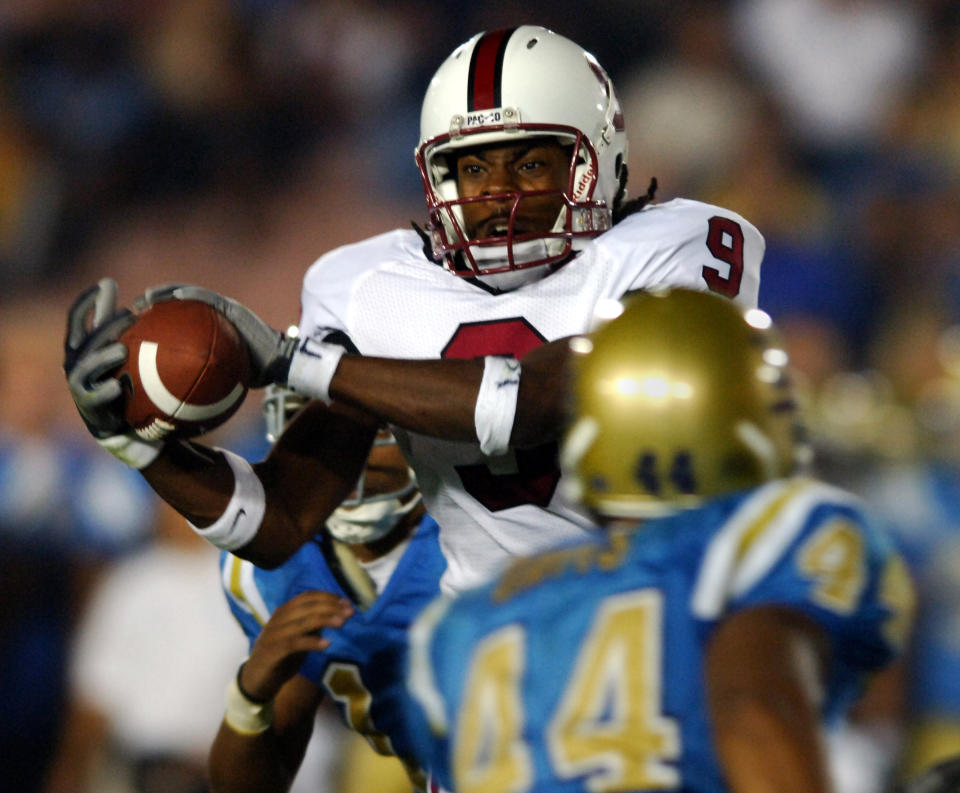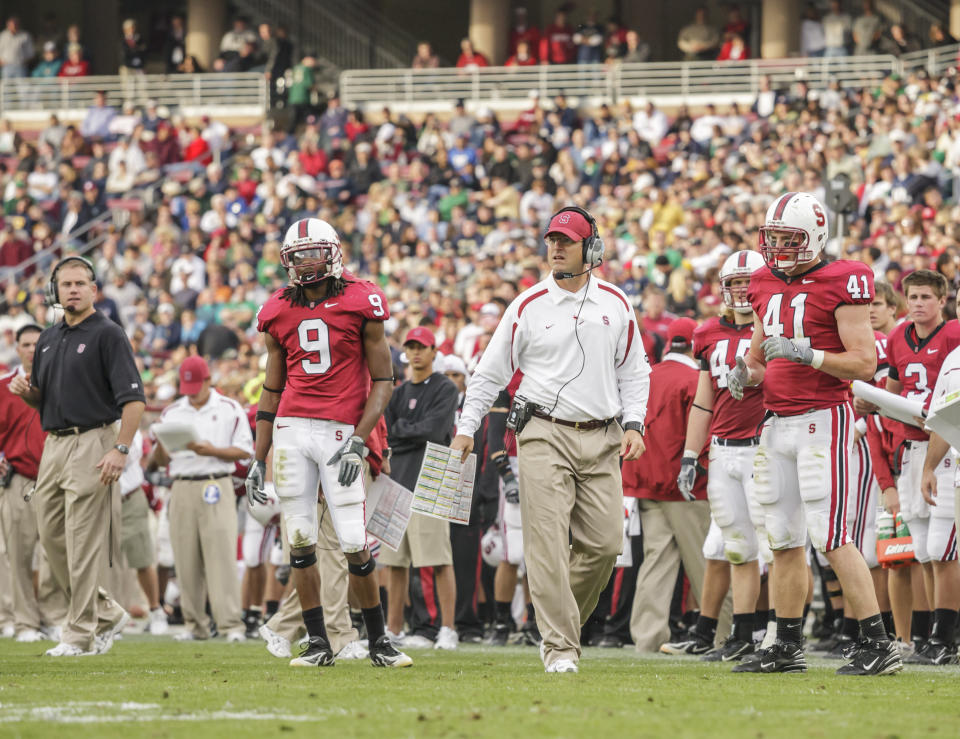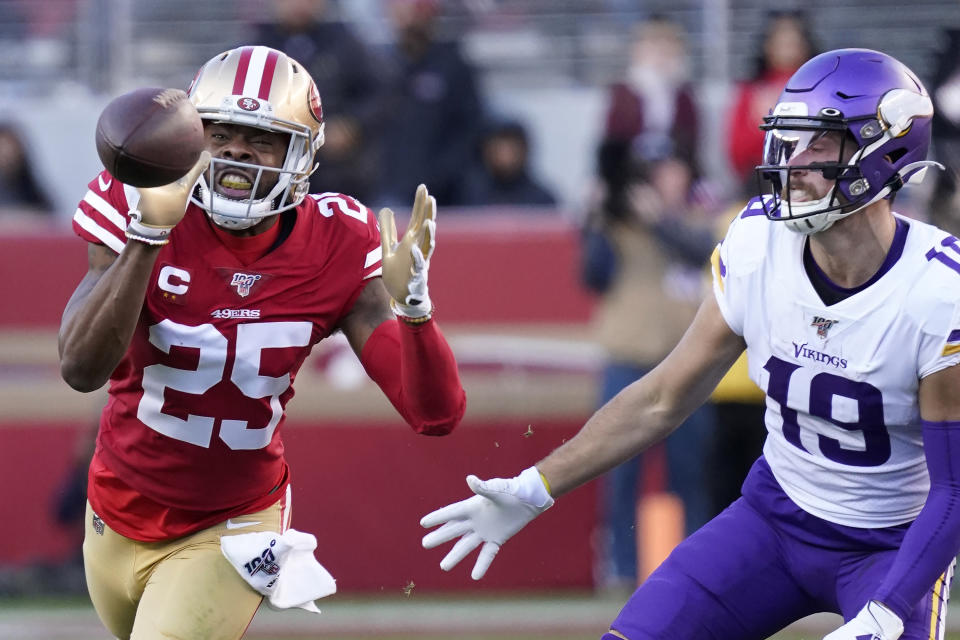How a beef with Jim Harbaugh has made Richard Sherman a future Hall of Famer
Before he became the NFL’s most feared lock-down corner and most bombastic trash talker, Richard Sherman was once a frustrated wide receiver at an impasse.
He didn’t want to squander his chance to earn a prestigious Stanford degree, but he could no longer tolerate playing for his head coach.
It had been a proud moment for Sherman in 2006 when he proved it was possible to go from Compton to Stanford, becoming the first Dominguez High School football player to accept a scholarship from the Cardinal in more than 20 years. Nothing could obstruct Sherman’s pursuit of that goal, not the temptation of drugs or gangs, not the burden of extra college-level classes, not even interest from nearby USC at the height of Pete Carroll’s reign.
Only a couple years later, Sherman found himself questioning whether Stanford was still the best place for him. His relationship with coach Jim Harbaugh had gone from contentious, to toxic, to unsalvageable, leaving Sherman unsure if he’d even see the field the following season, let alone reclaim his role as the team’s top downfield threat.
“Richard felt like he should get the ball more, Coach Harbaugh didn’t fully agree with that and it got worse from there,” said Andy Buh, Stanford’s linebackers coach and co-defensive coordinator at the time. “It was like oil and water. They just didn’t mix.”
Several times during a 2008 season plagued by conflict with Harbaugh and a knee injury that required arthroscopic surgery, Sherman called home wondering if he should transfer. “You might be upset with your coach, but you transferring out is not an option,” Beverly Sherman told her son. “Having that Stanford degree is going to help you throughout your life more than a degree from some other school.”
Seemingly stuck in a no-win situation, Sherman made a bold decision, one that many credit with saving his football career. Since Harbaugh was in charge of coaching the offense but delegated defensive duties to his staff, Sherman proposed a position switch: Stanford’s leading receiver asked to move to cornerback.
Growing discontent

As Sherman prepares for his third career Super Bowl on Sunday in Miami, much of his success can be traced back to his sudden position change. It’s the decision that paved the way for Sherman to win a championship in Seattle, to become the face and voice of the fearsome Legion of Boom and to help return a one-time NFC West rival to its former glory.
At the time of his move to corner, Sherman had limited experience playing the position. He dabbled at the position as a two-way player his senior season at Dominguez, most notably smothering Pete Carroll’s younger son in a state semifinal victory over Peninsula High School of Palos Verdes.
Whereas Carroll, perhaps not coincidentally, recruited Sherman out of high school as a big, physical cornerback, most college coaches envisioned him as a big-play receiver. Dominguez rarely passed out of its run-oriented Wing T system, yet Sherman still caught 14 touchdowns over his final two high school seasons and averaged more than 25 yards per reception.
It was Sherman’s blend of size, athleticism and competitiveness that appealed to Wayne Moses when the ex-Stanford assistant coach learned Dominguez had a promising receiver with a 4.1 GPA. In addition to making an impact at receiver and cornerback as a senior, the 6-foot-3 Sherman returned three punts for touchdowns and posted California’s best mark in the triple jump.
“Just watching him triple jump, you could see his speed and explosiveness and recognize how that would translate to football,” Moses said. “That was enough to get me to try to get him to come play for us.”
Sherman was one of Stanford’s only bright spots during a dismal 2006 season that ended with the firing of second-year coach Walt Harris. The freshman led Stanford in catches and receiving yards and took a fourth-quarter screen pass 74 yards to clinch the Cardinal’s lone victory of the season at Washington in mid-November.
Not long after Stanford hired Harbaugh in December 2006, the new coaching staff watched film of the previous season to familiarize themselves with the roster they were inheriting. Some of Sherman’s exploits brought a smile to the face of receivers coach David Shaw.
Recalled Shaw, “I remember thinking, ‘OK, we’ve got at least one receiver who can make a big play.’ ”
Sherman delivered some more “SportsCenter”-worthy highlights the following season. Not only did the sophomore again lead Stanford in receiving yards through the first eight games, he also produced the signature moment of a stunning upset victory over heavily favored USC, a gutsy fourth-and-20 catch that set up the Cardinal’s game-winning touchdown.
What Sherman’s production masked was his dissatisfaction at not being able to do more to help accelerate Stanford’s rebuilding process.
Reticent to trust either of the two unproven quarterbacks he inherited to make downfield throws, Harbaugh instead favored a conservative style in which he ran the ball more often than he passed it. Sherman wasn’t shy about asking for more targets and theatrically raising his voice or flinging his helmet if he didn’t get them.
“We saw the athleticism he had, but there were games when we honestly couldn’t get him the ball,” Shaw said. “At that point, we weren’t good enough as a team to take advantage of the talented guys that we had.”
Sherman’s frustration first spilled into the public eye late in the ninth game of the 2007 season, a 27-9 loss to Washington in which the sophomore caught only two passes for 11 yards and was penalized for unsportsmanlike conduct while covering a punt. Senior receiver Evan Moore urged his younger teammate to control his emotions, sparking a shoving match on the sideline.
Harbaugh suspended Sherman indefinitely after the game. Sherman sat out for only one game but caught only one pass for 5 yards the rest of the season.
By the end of that 4-8 season, Sherman had already begun to ponder moving from receiver to defensive back. He broached the idea with Shaw that offseason, but the wide receivers coach felt the position group couldn’t withstand the loss of Sherman.
“Richard was coming off a year where he averaged almost 17 yards per catch,” Shaw said. “I told him, ‘You can’t switch. I need you to stay at receiver.’ ”
Sherman vs. Harbaugh

Shaw might not have been so quick to shoot down the idea of Sherman switching positions if he knew the turmoil that lay ahead. The patellar tendon injury that Sherman suffered during the 2008 training camp further drove a wedge between the receiver and his head coach.
After tallying eight catches during Stanford’s first four games of the ’08 season, Sherman told his coaches that the discomfort was too much and underwent arthroscopic surgery. The timing preserved the possibility Sherman could redshirt and have two full years of eligibility remaining, leaving the door open for him to finish his Stanford degree in four years and play his last season of college football elsewhere as a graduate transfer.
On Oct. 2, 2008, Stanford announced that Sherman would miss four to six weeks. Told by local reporters that Sherman had written on Facebook that he was done for the season, Harbaugh responded, “That’s not what the doctor said. I don’t read Richard Sherman’s Facebook.”
While some of Harbaugh’s former assistant coaches called it “smart” of Sherman to try to save a year of eligibility, the head coach himself apparently saw it differently. Sherman told NBC Sports Bay Area last year that Harbaugh accused him of quitting on the team.
“I think in Harbaugh’s mind, Richard was done at that point,” Buh said. “He didn’t see the other side.”
It was around that time that Sherman approached Shaw for a second time about switching from receiver to defensive back. Sherman didn’t make any demands, but this time he was firmer in his request.
“It had gotten a little intense,” Beverly Sherman recalled. “He wanted to get as far away from Harbaugh as possible.”
This time Shaw didn’t stand in Sherman’s way. He gave Sherman permission to approach Harbaugh and said, “If he lets you switch, go ahead and switch.”
At a staff meeting before spring practice, Harbaugh floated the idea of Sherman transitioning to cornerback to his defensive coaches. To say they were receptive is a massive understatement.
Ex-Stanford defensive backs coach Clayton White had been hoping for an opportunity to try to mold Sherman into a lock-down corner for two years. In addition to Sherman’s physical tools, White admired the way he brought a competitive edge to every practice, the way he would use his motormouth to hold his teammates to the same high standards to which he held himself.
“Going against him as a receiver in 1-on-1s, your boys had to be mentally prepared for Sherman to let them know when he was successful,” White recalled with a laugh. “But that’s what I loved about Sherm. Me and him would go back and forth sometimes. He would talk trash about the DBs to me. As a coach keeping my professionalism, I couldn’t really step over the line, but I loved it. I’m not going to lie.”
White let others do the talking in the staff meeting until Harbaugh addressed him directly with a pivotal question.
“You think you can handle Sherm?” Harbaugh asked.
“Yessir,” White replied.
Right after the meeting, White texted Sherman that the position switch was now official. Within minutes, Sherman knocked on the door to White’s office ready to get to work.
Sherman makes the switch

In the winter of 2009, word of Sherman’s position change had begun to trickle out. Harbaugh dryly told reporters, "Don't know if he'll be able to beat anybody out over there or not."
That comment was all the motivation Sherman needed to attack his new position with urgency and enthusiasm. He analyzed film of how other rangy corners played, applied the knowledge he had accumulated at receiver and studied the press coverage techniques that his coaches taught him.
“His whole attitude changed,” Buh said. “He came out there so focused and determined to be a great DB. He played with a smile on his face. He became a completely different person. It was like he was coming home.”
In spring practice, Sherman used his knowledge of Stanford’s offense to his advantage even as he was still familiarizing himself with the nuances of the cornerback position. Often, he would identify where the ball was going before the snap and beat the intended receiver to that spot.
“I could just walk to spots and stand there at times,” Sherman said. “It would be annoying as heck to the offense, and they got tired of it. But it worked to my benefit and I still use that to this day."
For Sherman, the biggest challenge of his transition was where to direct his eyes. He got beat on a few too many double moves early in his junior season because he would look directly into backfields instead of keeping his eyes on the hips of the receiver he was checking.
Gradually, Sherman learned to anticipate where the quarterback would throw and to pounce without losing sight of his man. Sherman started at corner his final two years at Stanford, intercepting a pair of passes as a redshirt junior and tallying four picks as a fifth-year senior.
“I knew he was going to be special when he started using his offensive mindset at DB,” White said. “He figured out how to visualize the concepts the offense was trying to do and make plays on balls that weren’t his.”
Having secured his Stanford degree in June 2010 and led the Cardinal to an Orange Bowl win over Virginia Tech seven months later, Sherman turned his attention toward preparing for the NFL draft. His family confidently reserved a hotel suite in Las Vegas for night one, but it wasn’t until the fifth round that Seattle selected Sherman.
Of course, it wasn’t lost on Sherman that a certain team used a pick two rounds earlier to select a cornerback. The San Francisco 49ers, who hired Harbaugh as their new coach earlier that offseason, chose Chris Culliver in the third round instead of Sherman.
What Sherman didn’t realize at the time was that the situation he landed in was perfect. Carroll, by then the coach of the Seahawks, ran a system designed for big corners and had believed in Sherman’s potential to thrive in it since he was in high school.
As Sherman emerged as one of the NFL’s top corners, he made a point of tormenting Harbaugh whenever possible. “Happy birthday Coach Harbaugh! Hope you enjoyed it!” Sherman told the NFL Network minutes after a 42-13 prime-time rout of the 49ers on Harbaugh’s 49th birthday in 2012. Just over a year later in the NFC championship game against San Francisco, Sherman made an acrobatic tip in the end zone that led to a game-ending interception.
Now that Harbaugh is coaching at his alma mater Michigan and Sherman is with the 49ers, he has opened up about his rocky relationship with his college coach. Earlier this month, Sherman told the San Jose Mercury News, “The bridge in this particular relationship will never be rebuilt. I don’t think he is interested in it, and I’m not interested in it.”
Sherman may never let go of his grudge, but he owes Harbaugh some gratitude in at least one regard. Were Sherman not so dead-set on getting as far away from Harbaugh as possible, he might never have made the position switch that has put him on a path toward becoming one of the all-time greats of his era.
“He’s so determined that he might have made the NFL as a receiver too, but obviously he would not have accomplished what he has as a DB,” Buh said. “It’s crazy to think that he could have been a receiver his whole career. Luckily for Richard it happened this way instead.”
More from Yahoo Sports:


